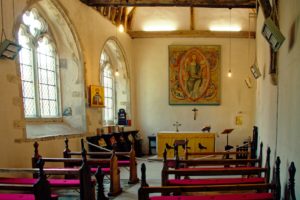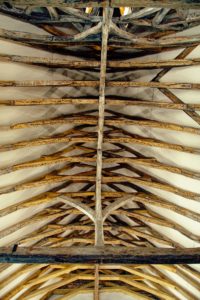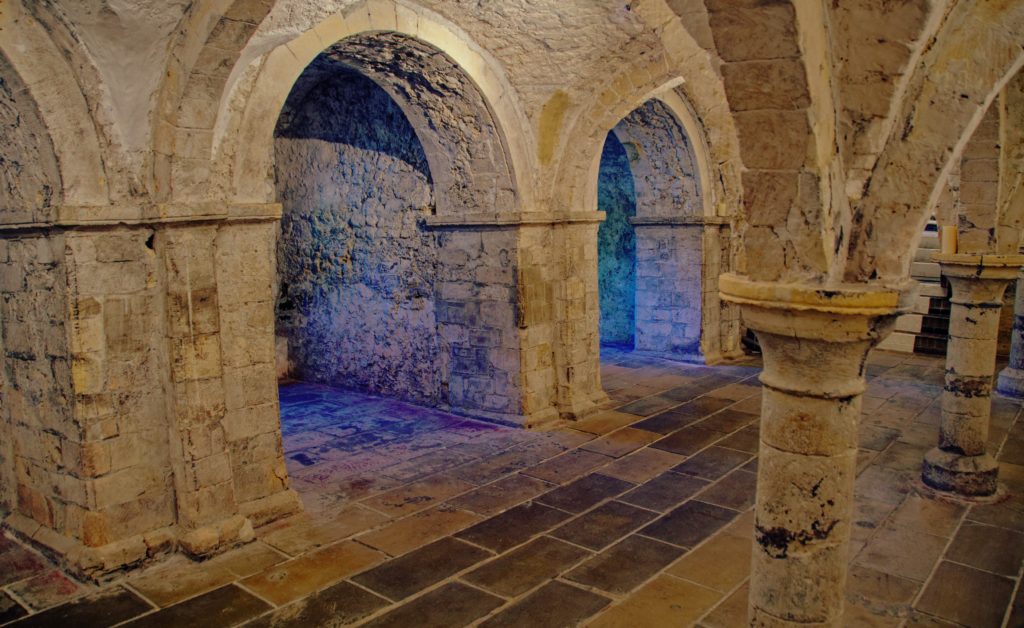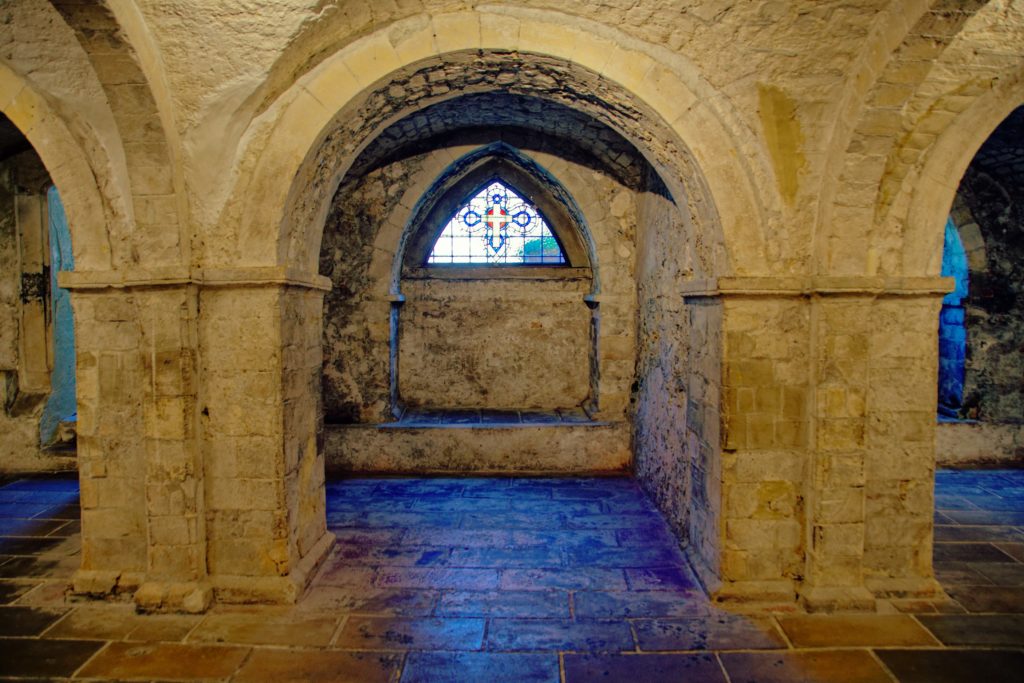
by Nigel Fletcher-Jones, PhD
Canterbury, in the eastern corner of England, was a city of saints. Eighteen archbishops were canonised before the Reformation and the remains of many other holy men and women were collected from elsewhere and deposited in its monasteries and churches.
Yet of its most famous saint, Thomas Becket (archbishop 1162-1170), no trace remains—unless one believes the claims of the nearby parish church at Chilham to secretly contain his relics.
Nonetheless, many tens of thousands of people still visit Canterbury cathedral each year, as they have since shortly after Becket’s murder by four of Henry II’s knights in December 1170, perhaps to contemplate the site where he was martyred or to marvel at the medieval stained glass representations of the miracles that were ascribed to him in the months and years following his death. The Martyrdom—the crime scene itself—had been substantially rebuilt between 1472 and 1487 in perpendicular style as part of a continuing struggle to accommodate pilgrims but separate them from the daily round of the monks. Nothing that can be identified certainly remains of the great shrine behind the high altar to which Becket’s remains were translated from the crypt in 1220. That was destroyed on the order of Henry VIII in 1538.
Yet we are not solely reliant on Chaucer’s Canterbury Tales in order to feel the presence of the pilgrims who started to arrive after the canonization of Becket in 1173 because of an extraordinary surviving building in the city’s high street – ‘Eastbridge Hospital’ or ‘the Hospital of Saint Thomas the Martyr’.
 Henry VIII’s commissioners and an earlier archbishop were convinced that the hospital—meaning here ‘a place of hospitality’ rather than ‘a place of treatment’—had been built by Thomas Becket, and given the saintly history of Canterbury that remains a possibility, but the first record we have concerning the building suggests that it was founded around 1180 by Edward fitz Odbold, a wealthy merchant of nearby St. Peter’s parish, for the benefit of poor pilgrims—a social stratum well below that of Chaucer’s travellers.
Henry VIII’s commissioners and an earlier archbishop were convinced that the hospital—meaning here ‘a place of hospitality’ rather than ‘a place of treatment’—had been built by Thomas Becket, and given the saintly history of Canterbury that remains a possibility, but the first record we have concerning the building suggests that it was founded around 1180 by Edward fitz Odbold, a wealthy merchant of nearby St. Peter’s parish, for the benefit of poor pilgrims—a social stratum well below that of Chaucer’s travellers.
It is a remarkable experience to step through the twelfth century archway from the main shopping street and down into the undercroft of the hospital where pilgrims would have slept, two to a bay, on straw or rushes strewn over the stone floor—these, hopefully, would be swept up occasionally. The River Stour flows on the west side of the undercroft so, no doubt, the floor would also have been damp or even flooded from time to time. In short, the accommodation would not have been comfortable, but it would have been better and safer than sleeping outside.
In times of plague the dangers of sleeping here would have been significantly higher as those that were in the initial stages of illness may have congregated in the hope of a miracle cure. The alarming number of ‘masters’ of the hospital in the fourteenth century seems to indicate that the senior administrators were not immune. This administrative complication was further exacerbated by the established right by the mid-14th century of those who died in Eastbridge Hospital to be buried in the south precinct of Christ Church (the current cathedral) in close proximity to Becket’s shrine.
Meals were provided for the pilgrims in the refectory above the undercroft and would have consisted of potage—oatmeal or wheat porridge–that might contain vegetables and, occasionally, fish or meat, together with bread and beer.

The refectory was completed a few years before 1200 and was originally two bays longer than at present, the remaining space having been used to construct alms-houses for female residents, or ‘in-sisters’, in the Tudor period. It is fortunate that the north end of hall survived as it is dominated by a 13th century mandorla of Christ in Majesty surrounded by the four evangelists that was discovered during renovation work in 1879. The extensive composition on this wall also included images of the murder of Becket, the public penance of Henry II (in July 1174), and the Last Supper, but all traces of these had disappeared by around 1900.

Before leaving for Christ Church and the shrine of St. Thomas, the pilgrims would have mounted a further set of steps leading up to the chapel. Though pierced by mid-14th century windows, the chapel was originally consecrated in the 1190s.

The rafters are a rare survival of a king’s strut construction—the beams hang of struts hanging straight down from the apex of the roof—dating to about 1280. The second bay of the timber construction is very complex and carried an octagonal belfry through the roof until this was cut down in the early 18th century.
The chapel (reconsecrated in 1927) was used as a schoolroom from 1569 to 1880 for the education of twenty schoolboys aged between seven and sixteen, and, remarkably, from its foundation the hospital has held two annual scholarships to Corpus Christi, Cambridge that are still awarded today. It is rumoured that a young Kit Marlowe may have been a student here before going on to the King’s School within the cathedral precincts.
Several further additions were made to the current building after its foundation, including another rare survival—a chantry chapel dedicated to Our Lady built around 1363 and consecrated by Simon Sudbury (archbishop 1375-1381) in 1375. Chantry chapels were usually established for the remembrance of family members and this example was added specifically for that purpose by Bartholomew of Bourne who moved the chapel that had previously been established at Bekesbourne by his ancestor James. The chantry priest was supported by the income from twenty-four acres of farmland at Bekesbourne and was also expected to support the spiritual needs of pilgrims.

A 1547 Act of Edward VI abolished all chantry chapels and seized their assets for the crown. Somewhat ironically, that this particular chapel has survived mostly intact may be because it was poorly built of chalk and flint nodules that were not worth the effort of reusing for other construction. In the 1920s the chapel was still in use as a wine store before being reconsecrated in 1969.
Soon after the translation of St. Thomas to the new shrine behind the high altar, the hospital began to accept a small number of lifelong dwellers, known as ‘corrodians’, who had given money or land in support of its charitable mission. Eventually this required further construction in and around the main body of the building, including, around 1405, a substantial timber extension across the River Stour that was subsequently modified several times to include rooms for recipients of alms (known as ‘in-dwellers’) and, on the third floor, to house the school master.
If mention of these modifications suggest that the financial foundations of Eastbridge Hospital changed greatly over time, the impression is correct. After only a few years of operation it became clear that the original endowment of Edward fitz Odbold was insufficient for the hospital’s needs. Archbishop Hubert Walter (in office 1193-1205) made a further endowment in 1203, during the reign of King John, giving the tithes associated with several mills in and around Canterbury. At the same time, the nearby Cokyn’s Hospital was combined with Eastbridge and the former was closed creating for a brief period a single Hospital of St. Nicholas, St. Catherine, and Saint Thomas the Martyr.
Several major benefactors associated with the village of Blean to the northwest of Canterbury came to its aid in the early 13th century. The Norman lord, Hamo de Crevequer, gave land and the church of Blean to the hospital by a number of undated charters and several of his tenants did likewise with regard to land. In the succeeding centuries other landholders in Blean followed suit.

Yet by 1342 the hospital was in a parlous state and Archbishop John de Stratford (1333-1348) essentially refounded the institution and laid down rules for its future management: healthy pilgrims might stay one night; sick pilgrims (excluding lepers) might stay until recovered; the right to burial in the south precinct of Christ Church was established for those who died at Eastbridge; pilgrims would be under the care of a woman over forty who would receive four pence a day to cover expenses; there would be twelve beds available (eight for men and four for women); and poor women in childbirth could be taken in.
By the beginning of the sixteenth century the golden age of pilgrimage had passed and such journeys to Canterbury ceased altogether with the destruction of Becket’s shrine in 1538 leaving Eastbridge Hospital with no obvious purpose. Fortunately, Archbishop Mathew Parker (in office 1559-1575) converted into a hospital for poor travellers and soldiers and added the school.

The rear of Eastbridge Hospital showing the building across the River Stour and, to the right, the Tudor cottages used as almshouses.
For reasons not quite understood, Elizabeth I gave over the hospital to a private individual, John Farneham in 1576, but Archbishop John Whitgift (1583-1604) purchased and refounded it in 1584 as an almshouse—adding two cottages to the rear of the building—in which status it has continued to the present with, currently, eight apartments for in-sisters and in-brothers.
Today, as one climbs up to exit the hospital through its gothic entrance arch and steps back into the glare of the High Street with its plastic, glass, and concrete shop fronts, it is heart-warming to look back and remember that at Eastbridge Hospital we still also have a frontage that has survived that, more or less, would have been familiar to Chaucer himself on his way long ago from London.




